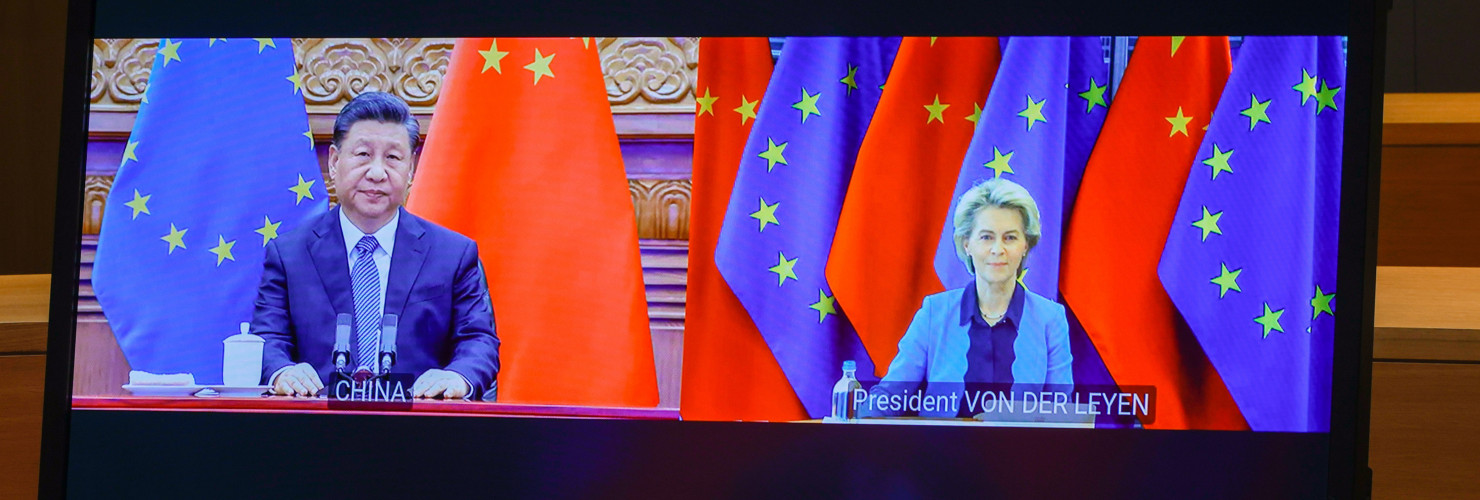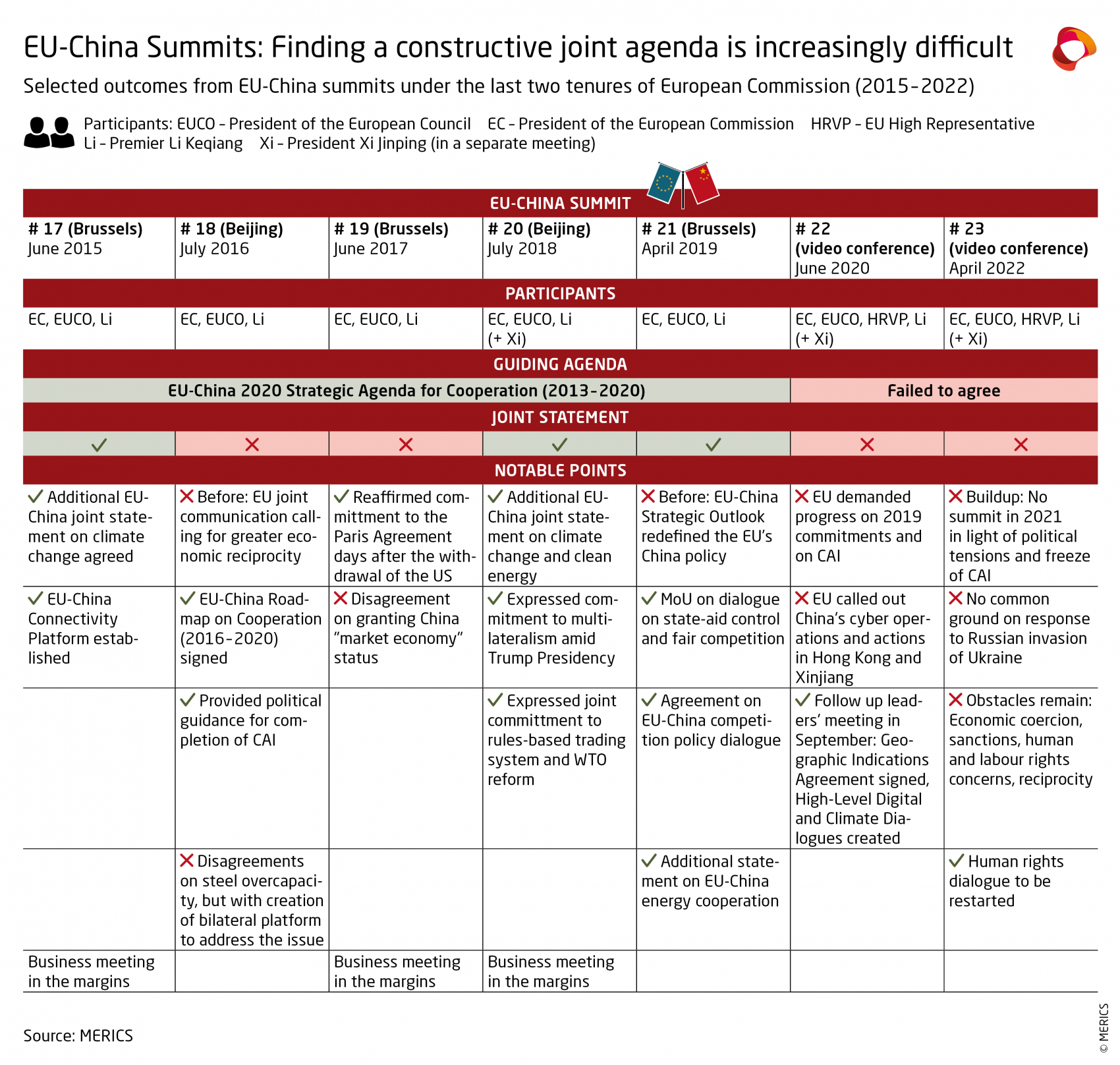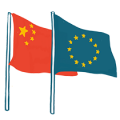

EU-China summit + EU-US summit
Analysis
Strategic-trust or -stalling: what does China want from the next EU-China summit?
By Grzegorz Stec
With the EU-China summit now scheduled for December 7–8, the countdown to set the agenda for Presidents von der Leyen and Michel’s first in-person summit has begun. What are China's objectives likely to be for the upcoming meeting?
Two key dynamics set the context for the summit
First, the EU’s struggle to transform de-risking from concept into practice while at the same time pursuing a post-zero-Covid re-engagement with China in a flurry of high-level dialogues. Despite having taken some measures, the EU is still looking for a clear way forward for de-risking vis-à-vis China. Questions on how to assess what constitutes tolerable risks and how to reduce vulnerabilities are still pending.
Second, given the slower-than-anticipated recovery of China's economy in 2023, Beijing likely sees an opportunity to hinder or weaken the EU's de-risking efforts. With their mandates ending next year, the European Parliament and the Commission will need to choose which policy files to accelerate and which to put on the backburner.
What Beijing may want
Currently, it does not seem that Beijing is eager to achieve ambitious deliverables to ink at this summit. Proposals to that effect would have had to be discussed during the rounds of high-level dialogues.
Strategic stalling will likely remain the dominant framework for China’s engagement with the EU – using primarily rhetoric and symbolic gestures to work towards its key preventive goals in relations with the EU. Namely, preventing closer transatlantic alignment on China and preventing the EU from limiting access to the single market and European tech.
At the summit, Beijing will likely try to:
- Present itself as a global actor supporting stability: Messaging over the need for cooperation on global governance in a time of instabilities such as in Eastern Europe or the Middle East can be expected;
- Hinder de-risking: Beijing will likely try to undermine any anti-subsidy investigations, criticizing de-risking as the trajectory of the relationship and pushing for dialogues as the alternative;
- Reassure EU actors on the direction of Chinese economy: The Chinese side will likely reiterate pro-market and pro-openness declarations.
Trust as a free remedy
During recent official visits and track 1.5 exchanges, China has signaled that it sees rebuilding strategic trust as the priority for EU-China relations and one that could alleviate the need for de-risking. In doing so, the logic goes, the pair could stabilize global governance and spare the economic cost of confrontations. Beijing has yet to explain how it thinks trust was broken and to signal concrete points of how to rebuild that trust.
Strategic trust requires predictability, adherence to rules and proof of actions. The EU provides China with such reliability by adherence to its country-agnostic approach to policies and compliance with WTO rules (see story below). In turn, EU trust towards China has been derailed by Beijing’s disrespect of the UN Charter amid Russia’s invasion of Ukraine, the disproportional response to the EU deployment of a human rights sanctions mechanism in 2021, or the multiplication of grey zone measures like economic coercion of Lithuania, information manipulation campaigns and the cracking down on international auditing and consulting companies in China.
What to expect from the next EU-China summit?
In recent years, the summits have become platforms for exchanging positions and engaging in damage control rather than for developing a positive agenda. On its side, the EU is highly unlikely to roll back its de-risking plans. Against this backdrop a joint statement appears, once again, unlikely.
The EU should be wary of Beijing’s proposals of establishing new dialogues and working groups if they do not have a clear objective. Instead, the bloc could strive to secure tactical or technical gains within reach that would be in line with the de-risking and “constructive rivalry” agenda highlighted by President von der Leyen in her EU China speech in Berlin last week.
Realistic targets could include: for China to improve the predictability of its business environment in the context of the new anti-espionage law or data flow regulations (with progress already achieved during High-level Digital Dialogue), jointly addressing international issues such as debt restructuring, sustainability efforts and standards in carbon and methane emission accounting, and market access points that do not contradict the de-risking agenda.
As the EU and China continue to diverge on fundamental geopolitical and economic issues, de-risking becomes an increasingly urgent task for the bloc. Beijing will try to undermine and stall those efforts at minimal, primarily rhetorical, price. The challenge ahead of Brussels is, therefore, to maintain commitment to de-risking agenda, but use Beijing’s re-engagement push to lock in progress on concrete, tactical and technical level issues. With the next summit only three weeks away, the clock is ticking.
Read more:
In case you missed it
Von der Leyen details de-risking approach in Berlin speeches
The EU Commission President elaborated on the need for more China literacy and the three pillars of the de-risking approach in speeches held at a conference hosted by MERICS and ECFR in Berlin and at a conference on the Indo-Pacific organized by Christian democrat parliamentarians in the Bundestag.
New MERICS project on European resilience vis-à-vis challenges posed by China
As part of a long-term research program funded by the EU, the China Horizons consortium, MERICS has developed a database of over 50 indicators on European country’s relations with China, focusing on the economy, political relations, security and society. The main trends are summarized in a series of profiles which will in turn feed into an audit of EU Member States’ and the UK’s resilience vis-à-vis China. The first edition of country profiles that includes, among others, France, Germany, Spain and Poland, was published in October. You can read the profiles here.
Update
The EU-US Summit – a gathering of unassuming significance
At the first EU-US Summit since June 2021 on October 20th, the EU and US struggled to advance on many key issues, especially those related to China, highlighting the challenges in fostering structured cooperation. This outcome is particularly concerning given the EU's strategy of holding summits with the US before engaging with China, to underscore stronger ties with its traditional ally. The prolonged visit of EU leaders, Presidents von der Leyen and Michel, and High Representative Borrell, in Washington failed to dispel the growing perception of waning transatlantic cooperation.
What you need to know:
- No alliance on China’s steel and aluminum: both sides had committed to establish a Global Arrangement on Sustainable Steel and Aluminum by November, a deadline now pushed back by two months. The arrangement is supposed to shield bilateral transatlantic trade flows from the Trump era tariffs on steel and aluminum – which the Biden administration maintained – and the forthcoming duties created by the European Carbon Border Adjustment Mechanism (CBAM). Washington has made it clear that any solution should also constrain market-access for Chinese products.
- Why not… yet: It remains to be seen how US objectives can be reached with respect to the World Trade Organization’s rules. This red line for Brussels and the Europeans prevents any preferential treatment for American products, or barriers against Chinese ones, that is not founded on scientific grounds. Given that Chinese steel and aluminum are not systemically more emission-intensive than US-made products, there is no clear way forward to reconcile redlines of the US and the EU.
- A slow-moving alignment on economic security: Jointly incentivizing a restructure of critical materials supply chains to exporters from like-minded countries, especially minerals, remains a realistic shared ambition. Attempts to coordinate an outflow-prevention of critical technology exports and know-how to China, be it through export controls or investment screening, also seem to lag behind ambitions. Joint efforts on standardization of key emerging technologies appear to be the most promising area. Both partners committed to supporting the G7-led guide of principles on artificial intelligence.
- A catch-up round to come: the Trade and Technology Council, set up at the 2021 EU-US summit is set to meet for a fifth time “later in 2023.” With elections looming in 2024 on both sides of the Atlantic, it will be one of the last occasions to deepen coordination on China related policies before the election period starts.
- Beijing‘s approving silence: typically quick to air its grievances on any transatlantic alignment, China’s party-state media and officials have remained abnormally quiet about the Summit.
Quick take: The accumulation of points of divergence – be it the international taxation of multinational firms, the technological containment of China or the economic consequences of the distortive US Inflation Reduction Act – are clogging the partnership. Also, the European agenda on economic security remains unclear. With elections looming in both Europe and the US, Europeans must get their act together if they want to deepen cooperation with the US on economic security and the China challenge.
The lack of traction in transatlantic cooperation could affect EU-China relations in the short run. As the US remains a vital pillar of security in Europe, European leaders will be particularly cautious to not send the wrong signal to the Biden administration by having a more positive outcome in their summit with Beijing than with Washington.
Read more:
- European Council: The US-EU Summit Joint Statement
- SCMP: US-EU summit yields call for balanced approach to China, urging ‘constructive and stable relations’
- Wilson Center: The US-EU Summit in Washington: Did it Meet Expectations? – Expert Quick Takes
- FT: Brussels defies US pressure to join its anti-China gang
Short takes
China’s Climate Envoy Xie Zhenhua set to retire – bad news for Europe
In December, after COP28 talks in Dubai, Xie, a veteran climate diplomat, will be replaced by Liu Zhenmin, a former vice-minister of foreign affairs and UN under-Secretary General. Xie was known as a politician able to deliver within the system and had good relations with EU Vice-President Frans Timmermans, responsible for climate, and with the US counterpart John Kerry. In turn, Liu has a track record of assertive positioning on China’s interests within the UN, including China’s position on Xinjiang. Building a new work relationship in climate dialogue relationship will not be easy for Timmermans’ successor as EU climate representative, Wopke Hoekstra, who took office in October.
- Reuters: China's veteran climate envoy Xie to step down in December - govt source
- Bloomberg: China Eyes Successor For Veteran Climate Chief Who Befriended US
Commissioners Breton and Hoekstra travel to China
Internal market Commissioner Thierry Breton visited Beijing between November 8 – 10 for discussions with China’s Vice Premier Zhang Guoqing, Minister of Commerce Wang Wentao and Minister of Industry and Technology Jin Zhuanglong. The visit was aimed at explaining the EU’s position on de-risking and “values-based visions for the development of key technologies.”
Climate Commissioner Wopke Hoekstra visited Beijing between November 15 – 16 for meetings with Xie Zhenhua and Environment minister Huang Runqiu. The visit aimed to explain the EU’s plans for the Carbon Border Adjustment Mechanism and introduce Hoekstra as the EU’s new climate counterpart for China.
- European Commission: In the geopolitics of blocs, Europe as a power of balance – Speech by Commissioner Breton
- AP: EU calls on China to stop building coal plants and contribute to a climate fund for poor nations
Global Gateway runs its first forum
In late October, 40 high-level representatives from developing countries, financial and international institutions gathered in Brussels for the Global Gateway Forum. Launched back in 2021, the initiative’s 90 projects are set to mobilize EUR 300 billion of development investment by 2027. But the Global Gateway continues to struggle to emerge from the shadow of the Belt and Road Initiative. President von der Leyen implicitly criticized the BRI in her opening speech, stating how other “investment options” often come at costs to environmental or labor practices, or compromise national sovereignty. Nevertheless, Chinese companies have been somewhat surprisingly invited to join Global Gateway advisory board.
- European Commission: Opening speech by President von der Leyen at the Global Gateway Forum
- IPQ: Will the EU’s Global Gateway Launch a “Race to the Top”?
- SCMP: 4 lost years: how the EU fumbled its response to China’s belt and road with Global Gateway strategy
David Cameron is back as UK foreign secretary: Return of the Golden era of engagement with China?
The former British Prime Minister championed this era of intense engagement with China. Following his departure from the role, Cameron has been actively involved in promoting the Belt and Road Initiative and Chinese investment projects, including by becoming a vice-president of a UK-China investment fund.
Taiwanese Minister of Foreign Affairs Joseph Wu tours the Baltics
The November 6 – 12 visit took Wu to all three Baltic capitals in a push for greater coordination of small democracies and to galvanize support for Taiwan across Europe. However, he also had to try to alleviate some of the region’s economic expectations towards Taiwan.
- CHOICE: Joseph Wu Tours the Baltics: Uplifting on Values, Convincing on Security, Discouraging on Economy
WTO panel on China’s economic coercion of Lithuania “not before” 2nd half of 2024
The WTO case filed by the EU against China over its alleged economic coercion towards Lithuania now has a clearer case schedule. The final report is now expected to be released “not before” the second half of 2024. The case pertains to China’s alleged activity at the end of 2021 and was filed by the EU to WTO in February 2022. The sluggish pace highlights the challenge the EU faces when attempting to respond to perceived coercive activities through existing international frameworks.
Serbia signs free trade agreement (FTA) with China
Under the agreement signed in mid-October, the two sides will eliminate tariffs on 90 percent of traded goods. Serbia is the first Central and Eastern European country to have an FTA with China, and the fourth European one (after Switzerland, Iceland and Georgia). The move creates additional hurdles for Serbia’s EU accession, as Belgrade had committed to withdrawing from bilateral FTA’s when joining the bloc.
- China Trade Monitor: China and Serbia Sign FTA



